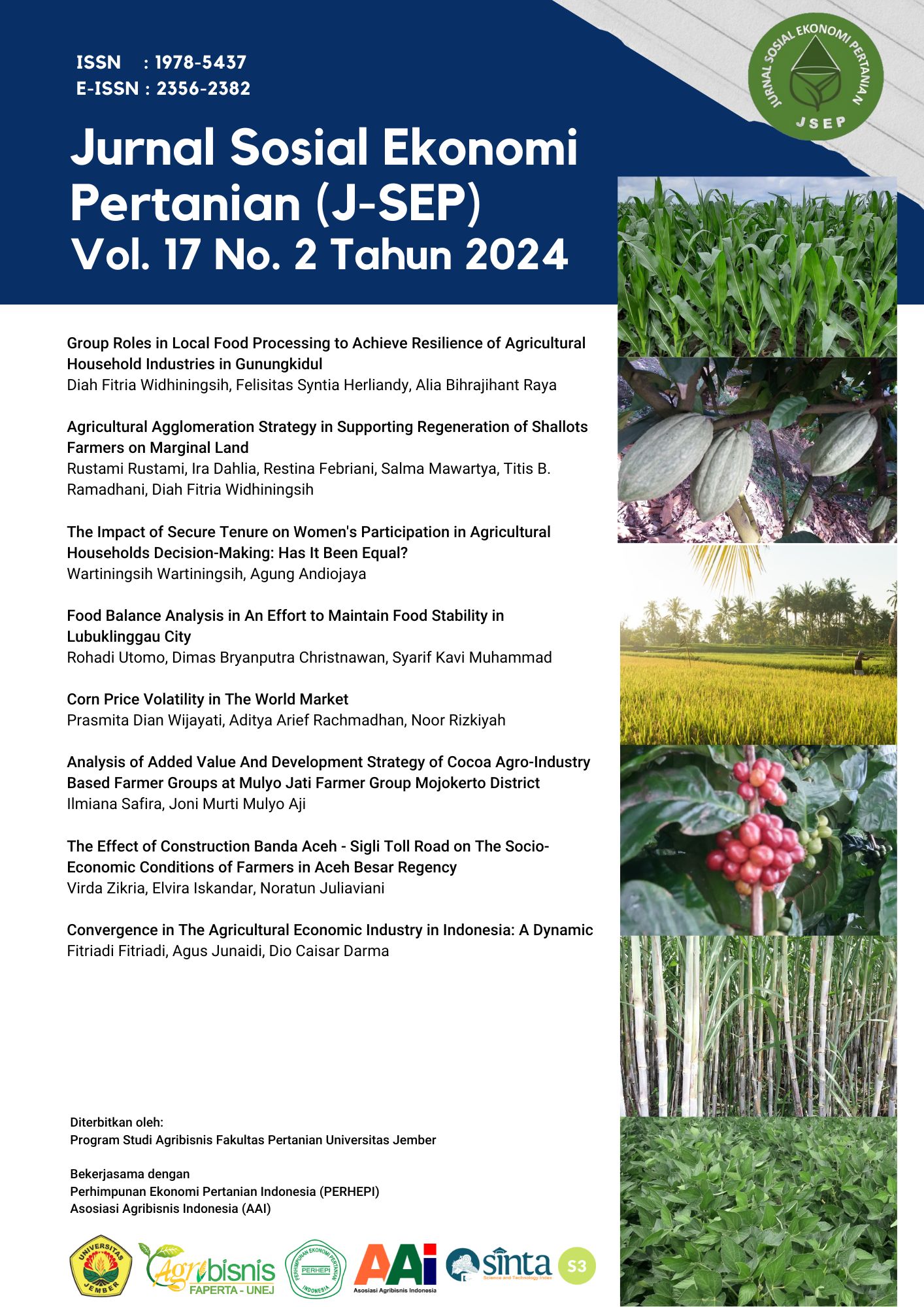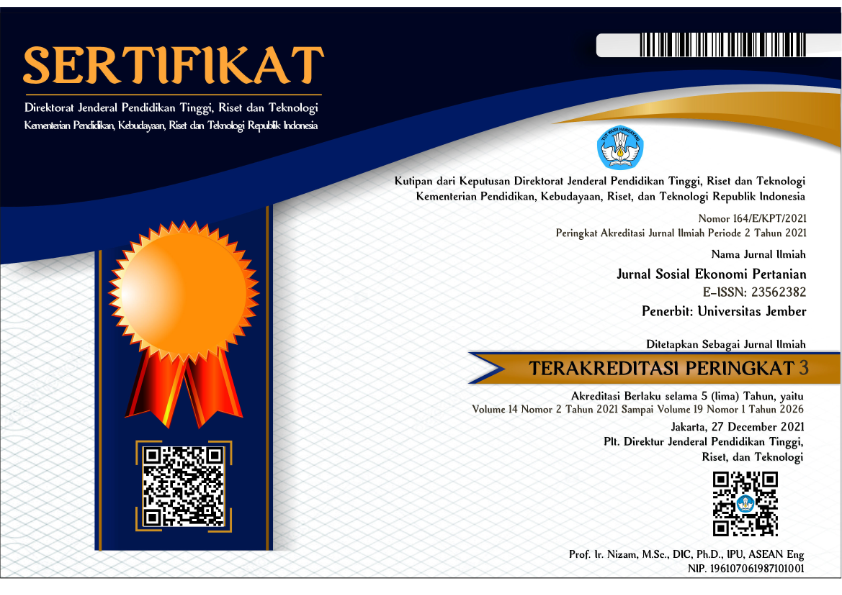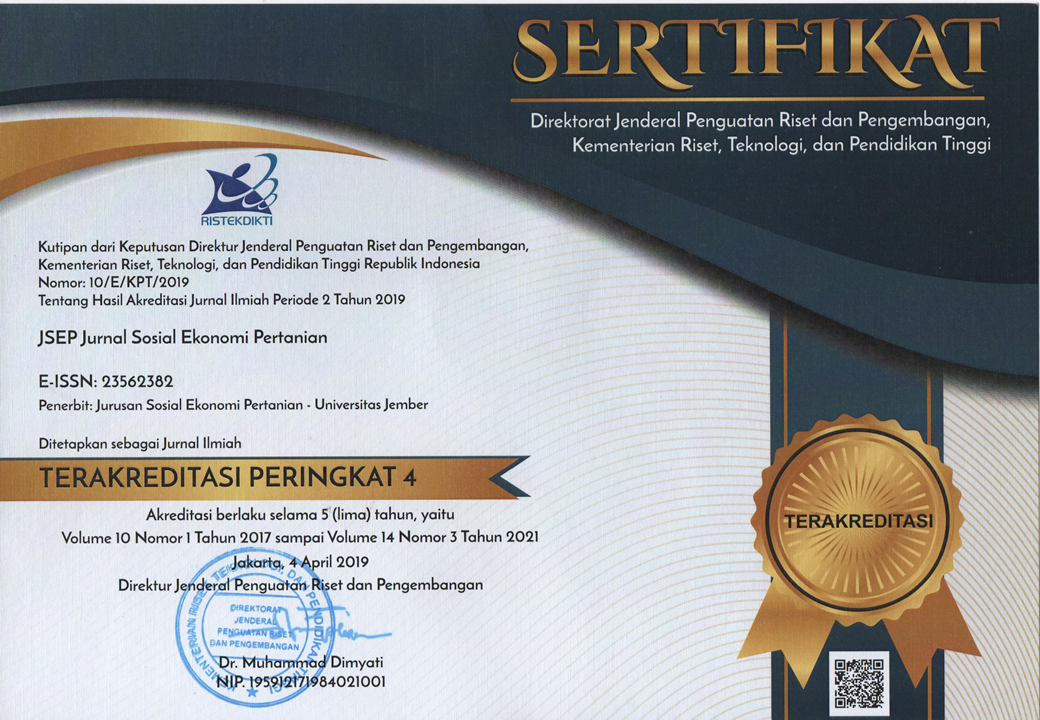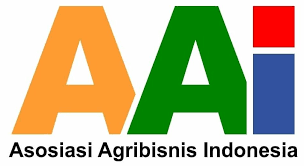Agricultural Agglomeration Strategy in Supporting Regeneration of Shallots Farmers on Marginal Land
Abstract
The declining interest of the younger generation to become farmers has implications for the crisis of farmer regeneration, which results in a decline in state income and increased import dependence. On the other hand, there is agglomerated marginal land farming in Srigading Village, Sanden Sub-district, Bantul which has increased agricultural yields in 2022. This research discusses the factors supporting and inhibiting the level of farmer regeneration to analyze the determinants of the success of agricultural agglomeration. This research was conducted in Srigading Village, Sanden District, Bantul Regency. This study used a qualitative approach with primary data from interviews with young farmers aged 20-35, old farmers aged over 35, non-farmers, extension workers, and government agencies to identify supporting and inhibiting factors for farmer regeneration. Furthermore, this research uses a case study and ecological-geographical approach, testing the validity of the data using the source triangulation method. The results show that aspects such as self, family, friends, government, social, social media, economy, and organization are both supporting and inhibiting factors for the level of agricultural regeneration, while aspects such as school and geography are neutral factors. Based on the interview results, agglomerated agricultural conditions facilitate access to knowledge, distribution of government assistance, and encourage innovation to develop agriculture. Spatial aspects such as distance between fields, exchange of information flows between farmers, collective use of resources, and government policies are determinants of the success of agglomeration strategies in supporting farmer regeneration.
References
Badan Pusat Statistik. (2020). Statistik Pemuda Indonesia 2020. URL: https://www.bps.go.id/publication/2020/12/21/4a39564b84a1c4e7a615f28b/statistik-pemuda-indonesia-2020.html. Diakses tanggal 23 Februari 2023.
Dinas Pertanian dan Ketahanan Pangan DIY. 2021. Pengukuhan Forum Komunikasi Petani Milenial Tingkat DIY URL: https://www.dpkp.jogjaprov.go.id/baca/Pengukuhan+Forum+Komunikasi+Petani+Milenial+Tingkat+DIY. Diakses tanggal 3 Oktober 2023.
Elmariska, Y., & Syahnur, S. (2020). Pengaruh Aglomerasi, Investasi, Dan Human Capital Terhadap Pertumbuhan Ekonomi Di Indonesia. Jurnal Ilmiah Mahasiswa Ekonomi Pembangunan, 5 (3):184-192.
Faysse, N., Phiboon, K. and Filloux, T. (2019). Public Policy to Support Young Farmers in Thailand. Outlook on Agriculture 48 (4):292–299.
Hadrian, E. (2022). Urgensi Konstitusionalisasi Pangan dalam UUD 1945. Syntax Literate: Jurnal Ilmiah Indonesia, 7 (11):15816-15823.
Hailu, G., & James Deaton, B. (2016). Agglomeration effects in Ontario's dairy farming. American Journal of Agricultural Economics, 98 (4):1055-1073.
Kusnandar, V. B. 2022. Sektor Industri Jadi Sektor Penopang Terbesar Ekonomi RI Kuartal II 2022. URL: https://databoks.katadata.co.id/datapublish/2022/08/05/sektor-industri-jadi-penopang-terbesar-ekonomi-ri-kuartal-ii-2022. Diakses tanggal 20 September 2023.
Li, E., Coates, K., Li, X., Ye, X., & Leipnik, M. (2017). Analyzing agricultural agglomeration in China. Sustainability, 9 (2):313.
Mutia, Annisa. 2022. Jadi Komoditas Andalan, Konsumsi Bawang Merah Sektor Rumah Tangga Naik 8,33% pada 2021. https://databoks.katadata.co.id/datapublish/2022/10/24/jadi-komoditas-andalan-konsumsi-bawang-merah-sektor-rumah-tangga-naik-833-pada-2021. Diakses tanggal 29 September 2023.
Nainggolan, Y. T. A., Wurarah, R. N., dan Riantoro, D. 2020. Analisis Pengaruh Aglomerasi Industri Pengolahan dan Pertanian Terhadap Hubungan antara Pertumbuhan Ekonomi dengan Ketimpangan Regional di Provinsi Papua Barat. Lensa Ekonomi. 11 (1):24-43.
Nugrahani, F., & Hum, M. (2014). Metode penelitian kualitatif. Solo: Cakra Books, 1 (1):3-4.
Nugroho, A. D., Waluyati, L. R., & Jamhari, J. 2018. Upaya Memikat Generasi Muda Bekerja Pada Sektor Pertanian di Daerah Istimewa Yogyakarta. JPPUMA: Jurnal Ilmu Pemerintahan Dan Sosial Politik Universitas Medan Area, 6(1), 76. https://doi.org/10.31289/jppuma.v6i1.1252
Rusastra, I. W., & Suryadi, M. (2004). Ekonomi tenaga kerja pertanian dan implikasinya dalam peningkatan produksi dan kesejahteraan buruh tani. Jurnal Litbang Pertanian, 23(3).
Richards, P. 2018. How Agglomeration Economies are Shaping New Agricultural Landscapes. Journal of Economic Geography. 18 (1):87-110.
Sidik, H. 2022. Alih Fungsi Lahan Pertanian Bantul 40 Hektare. https://jogja.antaranews.com/berita/349126/alih-fungsi-lahan-pertanian. Diakses tanggal 23 September 2023.
Sholihah, S. N. 2020. Outlook Bawang Merah. Pusat Data dan Sistem Informasi Pertanian Kementerian Pertanian. Jakarta.
Šūmane, S., Kunda, I., Knickel, K., Strauss, A., Tisenkopfs, T., des Ios Rios, I., ... & Ashkenazy, A. (2018). Local and farmers' knowledge matters! How integrating informal and formal knowledge enhances sustainable and resilient agriculture. Journal of Rural Studies, 59:232-241.
Tedjaningsih, T., Suyudi, & Nuryaman, H. (2018). Peran Kelembagaan dalam Pengembangan Agribisnis Mendong. Jurnal Pemikiran Masyarakat Ilmiah Berwawasan Agribisnis, 4 (2):210-226.

This work is licensed under a Creative Commons Attribution-ShareAlike 4.0 International License.
Jurnal Sosial Ekonomi Pertanian (J-SEP) has CC-BY-SA or an equivalent license as the optimal license for the publication, distribution, use, and reuse of scholarly work.
The work is simultaneously licensed under a Creative Commons Attribution-ShareAlike 4.0 International License, which permits others to share the work with an acknowledgement of the authorship and the work's initial publication in this journal. Authors who publish with this journal retain their copyright and grant the journal the right of first publication.


3.png)






.png)













